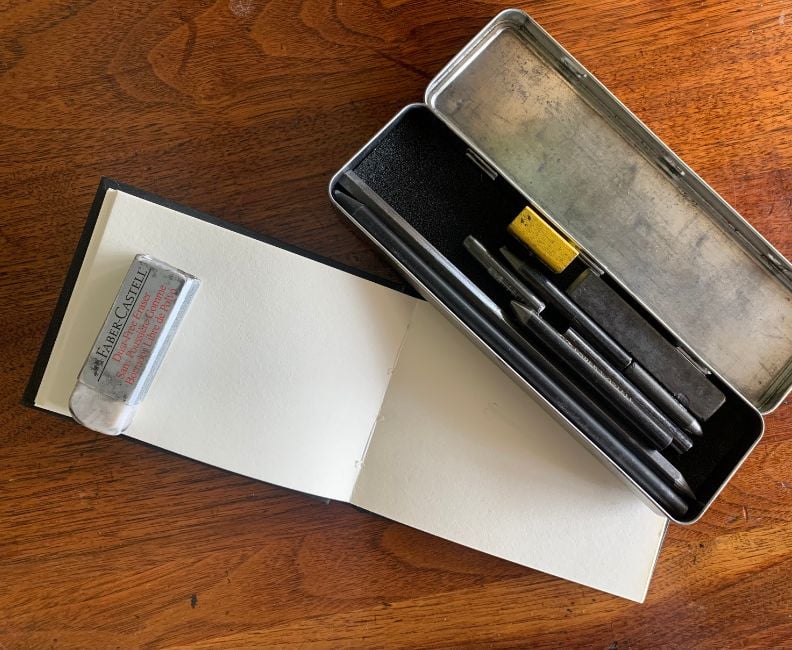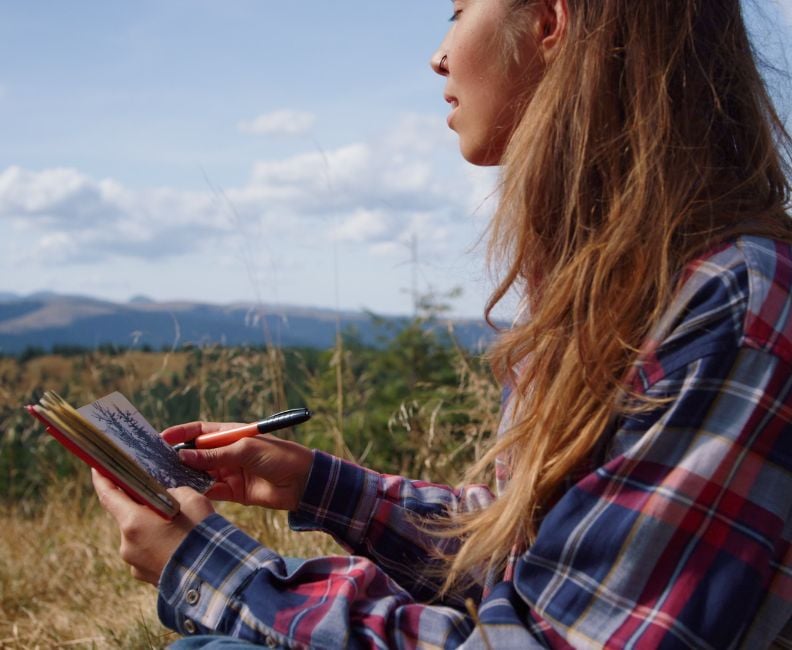Quick sketching is an essential skill to incorporate into your process as an artist. Sketching as a whole, helps to develop compositions and designs. But to unlock the full potential of sketching, it’s vital to know how to make quick sketches.
Translating ideas onto paper, along with capturing the essence of a diverse range of subject matter, is paramount for artists. This practice holds immense potential for enhancing one’s artistry, especially for painters who do not frequently engage in sketching. Here, I present three key focal points to aid you in mastering the art of quick sketching.
#1 Keep Your Tools at the Ready
An artist is as good as their tools. It’s essential to choose the right pencil, sketchbook, and other accessories that fit your style of sketching. If you don’t know what materials you like the most, try out different pencils, brushes, and tools to find the one that fits your style of sketching. Practicing with several options will inform your sketches’ texture, line thickness, and darkness, among other variable features.

Personally, I carry a small sketchbook with me at all times. It fits into my bag and or purse. So, if I ever have a spare moment or notice an interesting motif – then I can make a quick sketch.

Many artists of the past would practice the same. In fact, Leonardo da Vinci was known for carrying paper around with him everywhere so that he could put his ideas down into quick drawings. He made sketching part of his daily habit. Finding the tools that work best for your lifestyle is a great way to build a solid sketching habit for yourself.
#2 Practice the Art of Observation

Observation is the key to the art of quick sketching. It’s vital to take note of the subject’s shapes, tones, and texture, as well as the surrounding environment. This helps to place the object in its correct context, creating a better composition.
In order to master observational skills, it’s helpful to practice sketching while on a walk, observing people or nature, or even in a place of your choice. The more you practice observing, the better you’ll become at it, and the more accurate your sketches will become.
Focusing your quick sketch on a singular element

When making a quick sketch it is best to focus on one element. For example, you could decide to focus primarily on value and create a light and dark value sketch. Or, you could focus on line by creating a quick line drawing. If the colors you are seeing in your subject are most interesting to you, then make a sketch that focuses on the colors of your subject.
When you choose to focus your attention on one element, it helps you to keep your sketch quick and brief. It also helps you to simplify your subject matter as much as possible.
#3 Be Open to Your Subject
The point of making quick sketches is to not overthink what you will sketch. If something catches your eye and stands out to you, then sketch it! Don’t let yourself get overwhelmed by subject matter as this will prevent you from even starting.

The subject you choose to sketch could be something you are interested in making into a painting, or simply just wish to make a sketch of for the joy of drawing. You don’t always need a reason to sketch. A big part of being an artist is practicing to sketch out our ideas.

How to simplify while quick sketching
Once you see something that interests you, then simplify it. You will need to break down what you see so that you can sketch it quickly. Begin by placing the big shapes and then focus on the smaller details gradually. If you do struggle with getting caught up in details, then limit the time you spend on it with a stop watch.
The Power of Quick Sketching in Conclusion

Quick sketching is an essential skill for visual artists. It helps them capture the essence of the subject, develop composition and designs.
By applying the three key points of focus outlined above, an artist can learn how to create quick sketches with ease. Always remember to keep your tools with you, practice the art of observation, and be open to new subject inspiration.
A key part of the process as an artist (whether you’re a painter or work with another medium), is to generate a wealth of studies and inspiration that will help you to create your larger body of work. So, work to incorporate quick sketching into your drawing and painting process to achieve the growth in your work you desire!
Don’t forget to scroll down and leave me a comment below!






12 thoughts on “How to Master the Art of Quick Sketching (3 Key Points of Focus)”
It is winter time & I am finding more time to get back into my studio after a long distance move. I am enjoying what you have to say about quick sketching! I took my dad to many of his dr. appointments & always, always took my sketching materials with me. I find that while doing so, I could also make sales of my works or snag a custom order from someone while waiting for dad to be called in for his appointment. My vet fell in love with my dog & said, ‘I’ve always wanted a schnauzer!” Well, he did not get my dog…but he did get a very realistic sketch of my dog when i went to pick my dog up from the vet. hospital! One dr. recognized & even told me the names of some people I had sketched while in the waiting room…he recognized them! So I gave him the sketches…& it made his day! Art is so wonderful to do! Thank you for inspiring us to continue in our God given talents!
Hi Coleen, I am glad that you are now starting to be able to find more time in your studio after doing a long distance move. What a clever idea to have brought your sketchbook with you for appointments! A great way to use time and also make connections with others. You are so welcome – it is truly my pleasure
Hi Thanks for tips for quick sketching. You really hit on what I am trying to do right now.
I am planning to paint the death of hypatia but am confused how to start esp composition. I have a brief idea how it would look but there I stop!! Any suggestions are welcomed. Thanks and God bless,
You are so welcome Joe, am glad this was helpful! In regards to knowing where to start with planning out your painting, I would recommend looking at compositions of old master paintings. Find ones that you like and study their compositions by doing some master copy sketches. It might help to do a few thumbnail sketches from them so you can more clearly see what the basic light and dark values of the paintings are. The old master compositions that deal with mythological/ historical themes will likely be the most helpful in planning out your death of hypatia painting.
Thank you Elisabeth for the insightful words and explanations, sketching seems to be a stumbling block to me but will try to improve after your encouraging words, thanks again and have a nicecday 🙏
You are so welcome! Am very glad this article was helpful and encouraging for you to start sketching.
It was a good lesson in making quick sketching. Illustrations were only with human figures. You didn’t suggest anything about landscape or cityscape. Thank you for your guide lines.
Hello Tapan, Yes the drawings included in this article are of human figures – though the images do show people sketching from the landscape out of doors. I encourage sketching everything and anything that inspires. I do have articles about drawing landscapes and cityscapes.
Every bit of its good to hear you enjoy,I do also . More FUN!!!! Make the summer count.
Yes! Summer is a great time to do some quick sketching – especially outdoors!
I keep the sketch book and pencils by my recliner so I can sketch while my husband watches TV. I take them on trips and use them on vacation.
I have sketched my feet, things in the room, furniture and even my husband! Thanks for your words of encouragement, Elizabeth!
Hi Sandy, That is wonderful that you keep your sketchbook handy to draw during available moments in the day! Am so glad this was encouraging. Thanks for sharing and your tip on keeping a sketchbook handy by the tv! 🙂